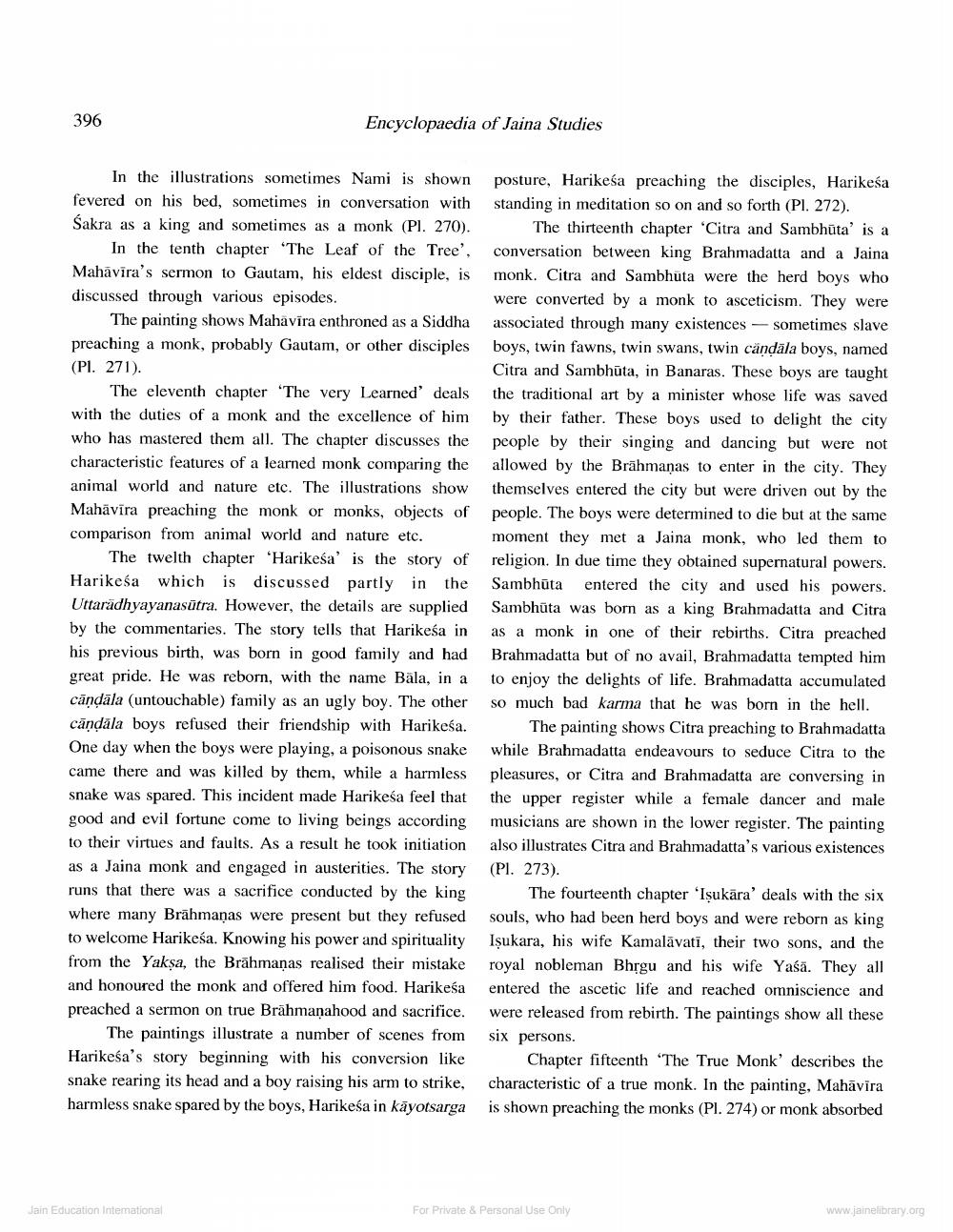________________
396
Encyclopaedia of Jaina Studies
In the illustrations sometimes Nami is shown fevered on his bed, sometimes in conversation with Śakra as a king and sometimes as a monk (Pl. 270).
In the tenth chapter 'The Leaf of the Tree', Mahāvīra's sermon to Gautam, his eldest disciple, is discussed through various episodes.
The painting shows Mahavira enthroned as a Siddha preaching a monk, probably Gautam, or other disciples (Pl. 271).
The eleventh chapter 'The very Learned' deals with the duties of a monk and the excellence of him who has mastered them all. The chapter discusses the characteristic features of a learned monk comparing the animal world and nature etc. The illustrations show Mahavira preaching the monk or monks, objects of comparison from animal world and nature etc.
The twelth chapter 'Harikeśa' is the story of Harikeśa which is discussed partly in the Uttaradhyayanasutra. However, the details are supplied by the commentaries. The story tells that Harikeśa in his previous birth, was born in good family and had great pride. He was reborn, with the name Bäla, in a cāndāla (untouchable) family as an ugly boy. The other cāndāla boys refused their friendship with Harikeśa. One day when the boys were playing, a poisonous snake came there and was killed by them, while a harmless snake was spared. This incident made Harikeśa feel that good and evil fortune come to living beings according to their virtues and faults. As a result he took initiation as a Jaina monk and engaged in austerities. The story runs that there was a sacrifice conducted by the king where many Brāhmaṇas were present but they refused to welcome Harikeśa. Knowing his power and spirituality from the Yakṣa, the Brahmanas realised their mistake and honoured the monk and offered him food. Harikesa preached a sermon on true Brāhmaṇahood and sacrifice.
The paintings illustrate a number of scenes from Harikesa's story beginning with his conversion like snake rearing its head and a boy raising his arm to strike, harmless snake spared by the boys, Harikeśa in kayotsarga
Jain Education International
posture, Harikeśa preaching the disciples, Harikesa standing in meditation so on and so forth (Pl. 272).
The thirteenth chapter 'Citra and Sambhuta' is a conversation between king Brahmadatta and a Jaina monk. Citra and Sambhuta were the herd boys who were converted by a monk to asceticism. They were associated through many existences sometimes slave boys, twin fawns, twin swans, twin candāla boys, named Citra and Sambhūta, in Banaras. These boys are taught the traditional art by a minister whose life was saved by their father. These boys used to delight the city people by their singing and dancing but were not allowed by the Brāhmaṇas to enter in the city. They themselves entered the city but were driven out by the people. The boys were determined to die but at the same moment they met a Jaina monk, who led them to religion. In due time they obtained supernatural powers. Sambhūta entered the city and used his powers. Sambhuta was born as a king Brahmadatta and Citra as a monk in one of their rebirths. Citra preached Brahmadatta but of no avail, Brahmadatta tempted him to enjoy the delights of life. Brahmadatta accumulated so much bad karma that he was born in the hell.
The painting shows Citra preaching to Brahmadatta while Brahmadatta endeavours to seduce Citra to the pleasures, or Citra and Brahmadatta are conversing in the upper register while a female dancer and male musicians are shown in the lower register. The painting also illustrates Citra and Brahmadatta's various existences (Pl. 273).
The fourteenth chapter 'Iṣukara' deals with the six souls, who had been herd boys and were reborn as king Işukara, his wife Kamalavati, their two sons, and the royal nobleman Bhrgu and his wife Yasa. They all entered the ascetic life and reached omniscience and were released from rebirth. The paintings show all these six persons.
Chapter fifteenth 'The True Monk' describes the characteristic of a true monk. In the painting, Mahavira is shown preaching the monks (Pl. 274) or monk absorbed
For Private & Personal Use Only
www.jainelibrary.org




